Trong thế giới đầy màu sắc và sự kỳ diệu, việc học tiếng Anh không chỉ là một nhiệm vụ mà còn là một hành trình phiêu lưu đầy thú vị. Dành cho các bé từ 4 đến 5 tuổi, chúng tôi đã chuẩn bị một loạt bài tập viết tiếng Anh với âm thanh đáng yêu, giúp bé không chỉ học được cách viết mà còn cảm nhận và yêu thích ngôn ngữ này qua những hình ảnh và âm thanh quen thuộc. Hãy cùng bé khám phá và trải nghiệm những bài tập thú vị sau đây!
Hình Ảnh và Văn Bản
- Hình Ảnh:
- Một cây thông xanh um.
- Một con cá bơi trong ao.
- Một đám mây bồng bềnh trên bầu trời.
- Một con gà chạy trong vườn.
- Một con bò ăn cỏ trên đồng.
- Một cơn mưa rào đột ngột.
- Một con thuyền chèo trên sông.
- Văn Bản:
- “Look at the tall tree with green leaves. Can you find the word ‘tree’?”
- “What do you see in the water? Can you find the word ‘fish’?”
- “The clouds are fluffy and white. Can you find the word ‘clouds’?”
- “There is a chicken running in the garden. Can you find the word ‘chicken’?”
- “The cow is eating grass in the field. Can you find the word ‘cow’?”
- “It’s raining. Can you find the word ‘rain’?”
- “The boat is sailing on the river. Can you find the word ‘boat’?”
Cách Chơi
- Trẻ em được yêu cầu tìm các từ ẩn trong đoạn văn bản kèm theo mỗi hình ảnh.
- Khi tìm thấy từ, trẻ em có thể đọc to và giải thích ý nghĩa của từ đó.
- Trẻ em có thể sử dụng các từ đã tìm thấy để kể một câu chuyện ngắn hoặc vẽ một bức tranh mô tả môi trường xung quanh.
Hoạt Động Thực Hành
- Trẻ em có thể tạo một cuốn sách nhỏ bằng cách dán các hình ảnh và văn bản vào trang giấy.
- Trẻ em có thể chơi trò chơi “Bí ẩn Môi Trường” với bạn bè hoặc gia đình, nơi họ phải tìm các từ ẩn và kể câu chuyện dựa trên các từ đó.
Lợi Ích
- Giáo Dục: Giúp trẻ em học từ mới và hiểu biết về môi trường xung quanh.
- Kỹ Năng: Phát triển kỹ năng đọc, viết và tưởng tượng.
- Thích Nghi: Cung cấp một cách vui chơi và học tập tích cực.
Kết Thúc
- Sau khi hoàn thành trò chơi, trẻ em có thể được khen thưởng hoặc nhận phần quà nhỏ để khuyến khích sự tham gia của họ.
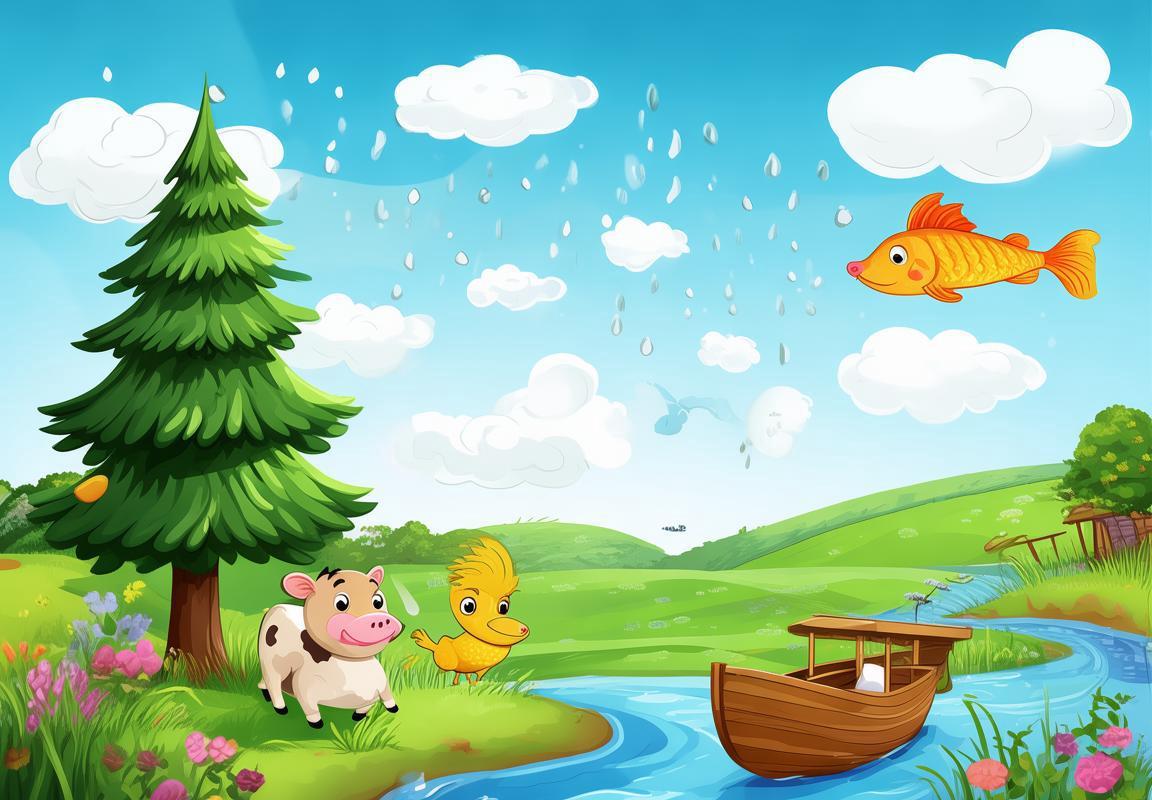
Văn Bản Đề Xuất
Câu 1: “Good morning, kids! Today, we are going on a magical journey to a beautiful forest. Can you guess what time it is?”
Câu 2: “Look at the sun. It’s shining brightly. It must be around 10 o’clock in the morning. What do you think?”
Câu 3: “As we walk through the forest, we hear the birds chirping. It’s almost lunchtime. Do you know what time lunch is?”
Câu 4: “After lunch, we take a nap under the big tree. The forest is quiet and cool. Can you guess what time it is now?”
Câu 5: “When we wake up, it’s time for an adventure. We find a hidden path and follow it. The sun is setting, and it’s getting dark. What time do you think it is now?”
Câu 6: “We hurry back to the campsite before it gets too dark. As we arrive, we see a campfire burning. It’s almost bedtime. What time do you think it is?”
Câu 7: “We say goodnight to the stars and sleep under the stars. The next morning, the sun rises again, and a new day begins. What time do you think it is now?”
Câu 8: “Can you tell me the time of day when the sun is shining, the birds are chirping, it’s time for lunch, we take a nap, we have an adventure, it’s getting dark, and we go to bed?”
Câu 9: “Great job, kids! You did a fantastic job guessing the time of day in our forest adventure. Let’s go back to the classroom and learn more about time together!”
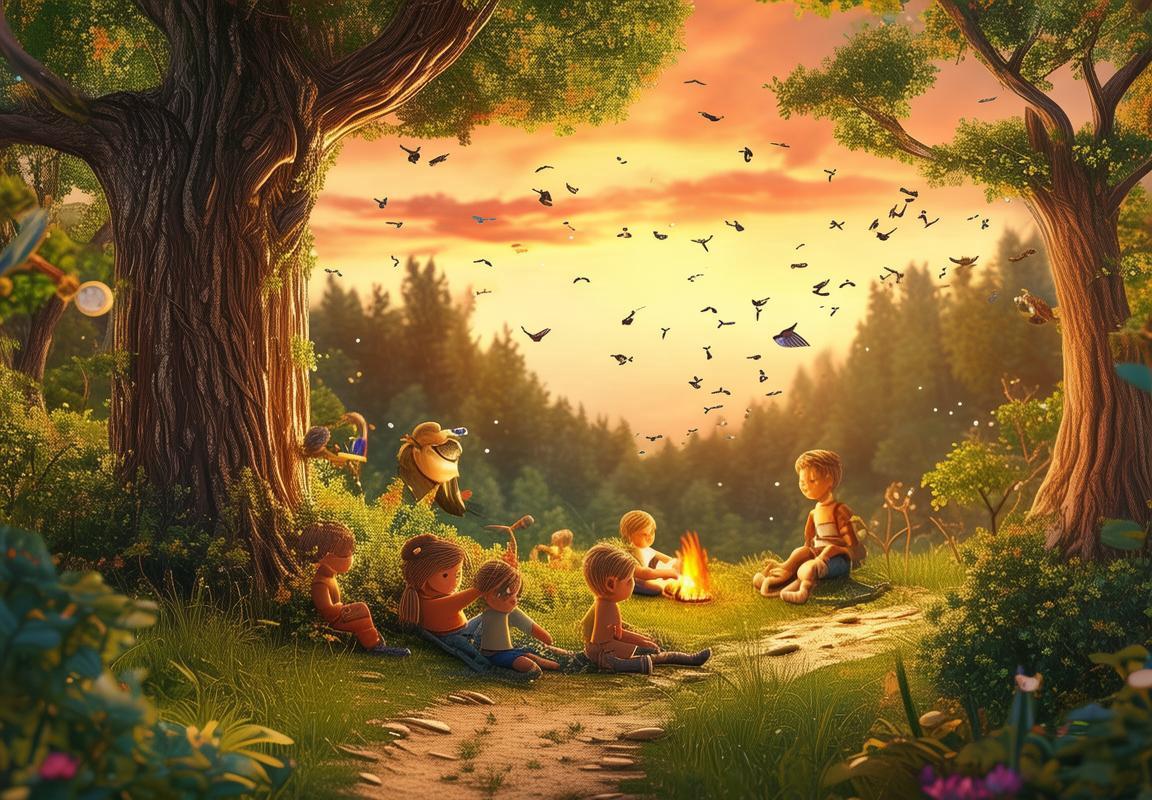
This is a tall tree with green leaves
Bài Tập Viết Chữ Tiếng Anh Có Âm Thanh Rất Đáng Yêu Cho Trẻ Em 4-5 Tuổi
- Hình Ảnh và Văn Bản:
- Hình ảnh: Một con gấu nâu đang vui chơi trong rừng.
- Văn bản: “Look at the bear! It’s playing with the leaves.”
- Bài Tập 1:
- Hình ảnh: Một cây thông xanh mướt với những quả óc chó.
- Văn bản: “The tree is green. The acorns are on the tree.”
- Bài Tập 2:
- Hình ảnh: Một chú mèo đang nhảy qua hàng rào.
- Văn bản: “The cat is jumping over the fence.”
- Bài Tập 3:
- Hình ảnh: Một con bò đang uống nước ở ao.
- Văn bản: “The cow is drinking water from the pond.”
- Bài Tập 4:
- Hình ảnh: Một chú chó đang chạy đuổi bóng.
- Văn bản: “The dog is running after the ball.”
- Bài Tập 5:
- Hình ảnh: Một con gà con đang đi theo gà mẹ.
- Văn bản: “The chick is following the hen.”
- Bài Tập 6:
- Hình ảnh: Một con cá bơi lội trong ao.
- Văn bản: “The fish is swimming in the pond.”
- Bài Tập 7:
- Hình ảnh: Một con chim đang đậu trên cành cây.
- Văn bản: “The bird is sitting on the branch.”
- Bài Tập 8:
- Hình ảnh: Một con khỉ đang chơi đùa trong rừng.
- Văn bản: “The monkey is playing in the forest.”
- Bài Tập 9:
- Hình ảnh: Một con thỏ đang nhảy qua đồng cỏ.
- Văn bản: “The rabbit is hopping across the grass.”
- Bài Tập 10:
- Hình ảnh: Một con cá voi đang bơi lội trong đại dương.
- Văn bản: “The whale is swimming in the ocean.”
Lưu Ý:– Các bài tập này có thể được in ra và dán lên tường hoặc bảng để trẻ em dễ dàng theo dõi và thực hành.- Giáo viên hoặc phụ huynh có thể đọc to văn bản và giúp trẻ em viết theo.- Trẻ em có thể được khuyến khích vẽ thêm hình ảnh hoặc minh họa cho văn bản nếu họ cảm thấy hứng thú.

These are small creatures that live in the forest
Tạo trò chơi đoán từ tiếng Anh cho trẻ em, sử dụng hình ảnh động vật nước làm trợ giúp
Mục tiêu:– Giúp trẻ em học từ tiếng Anh liên quan đến động vật nước.- Phát triển kỹ năng nhận biết và trí nhớ.
Cách chơi:1. Chuẩn bị:– Lên danh sách các từ tiếng Anh liên quan đến động vật nước như fish, turtle, dolphin, shark, octopus, whale, etc.- Chuẩn bị hình ảnh của các động vật này.
- Bước 1:
- Giáo viên hoặc người lớn chọn một từ tiếng Anh và cho trẻ nhìn vào hình ảnh tương ứng.
- Trẻ em cần phải nói ra từ tiếng Anh mà họ nhìn thấy.
- Bước 2:
- Giáo viên hoặc người lớn giấu một hình ảnh động vật nước và yêu cầu trẻ em đoán từ bằng cách chỉ vào hình ảnh.
- Trẻ em có thể hỏi một số câu hỏi đơn giản như “Is it big?” hoặc “Does it swim?” để giúp họ đoán ra từ.
- Bước 3:
- Sau khi trẻ em đoán đúng từ, giáo viên hoặc người lớn có thể đọc thêm một câu chuyện ngắn về động vật đó để trẻ em hiểu thêm về nó.
- Bước 4:
- Thực hiện trò chơi này theo từng từ, thay đổi hình ảnh và từ tiếng Anh để trẻ em không cảm thấy nhàm chán.
Ví dụ Cách Chơi:
Giáo viên: Look at the picture. What is it? (Trẻ em nhìn vào hình ảnh cá)Trẻ em: It’s a fish!
Giáo viên: Yes, that’s right! A fish. It lives in the water. Do you know what else lives in the water? (Trẻ em nhìn vào hình ảnh rùa)Trẻ em: It’s a turtle!
Giáo viên: Correct! A turtle. It has a hard shell. Do you want to hear a story about a fish? (Trẻ em đồng ý)
Giáo viên: Once upon a time, there was a little fish named Finny. Finny loved swimming in the ocean. One day, Finny met a big turtle named Tilly. They became the best friends. They swam together every day and explored the ocean. (Trẻ em lắng nghe và hứng thú)
Kết Luận:– Trò chơi này không chỉ giúp trẻ em học từ tiếng Anh mà còn tăng cường kỹ năng giao tiếp và trí nhớ.- Giáo viên có thể tùy chỉnh trò chơi để phù hợp với mức độ hiểu biết và khả năng của trẻ em.
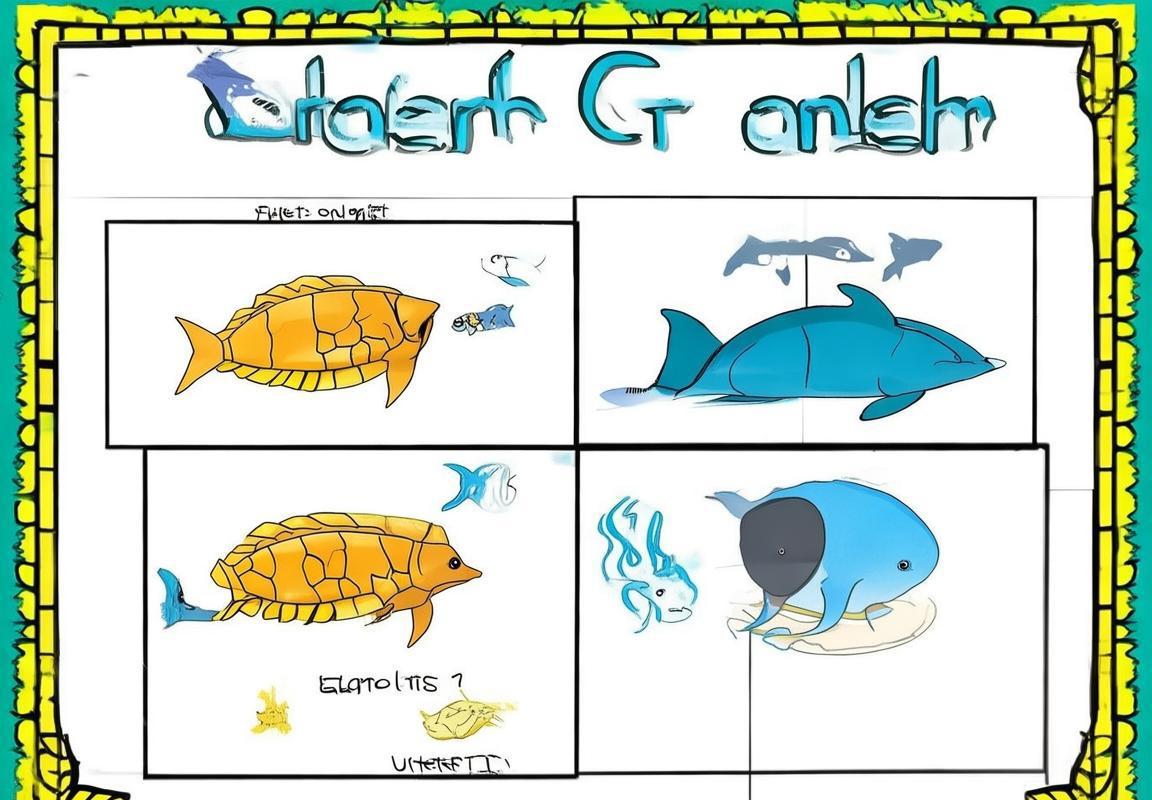
The sun is shining brightly in the sky
Câu chuyện ngắn tiếng Anh về cuộc phiêu lưu của chim trắng trong công viên
Once upon a time, in a beautiful park filled with colorful flowers and tall trees, there was a white bird named Wally. Wally was not just any bird; he was the bravest and most curious bird in the park.
One sunny morning, Wally decided to go on a great adventure. He flapped his wings and soared high into the sky, looking for new places to explore. As he flew, he noticed a bright, shiny object in the distance. It was a sparkling lake, reflecting the sun’s rays like a mirror.
Wally was fascinated by the lake and decided to visit it. He descended gracefully, landing on a lush, green branch by the water’s edge. The lake was home to many different creatures, and Wally was excited to meet them.
As he walked along the shore, he met a friendly frog named Freddie. Freddie was sitting on a lily pad and croaking happily. “Hello, Wally! What brings you to the lake today?” Freddie asked.
“Hello, Freddie! I’m on an adventure to see the world,” Wally replied. “I heard there are many interesting creatures here, and I wanted to meet them all.”
Freddie nodded enthusiastically. “That’s a great idea! Let me introduce you to my friends. This way!”
Freddie led Wally to meet a group of playful ducks. The ducks were quacking and splashing in the water, having a wonderful time. “Hello, Wally! We’re the Duck Family. Come and join us for a swim!” the oldest duck said with a smile.
Wally was thrilled and joined the ducks in the water. They swam around the lake, laughing and splashing. After a while, they saw a fish darting under the water. The fish was very shy, but Wally approached it gently.
“Hello, little fish,” Wally said softly. “I’m Wally. I’m new here and I want to learn about the park.”
The fish peeked out of the water and said, “Hello, Wally! I’m Fishy. The park is amazing, but you have to be careful with the currents.”
Wally thanked Fishy and continued his adventure. He met a wise old owl named Oliver, who lived in a large tree near the lake. Oliver told Wally many stories about the park and its creatures.
As the day came to an end, Wally realized that his adventure was just beginning. He had learned so much about the park and its inhabitants. He decided to make the park his new home and help protect all the creatures that called it their own.
And so, Wally the white bird became the guardian of the park. He shared his adventures with the other creatures, teaching them to be kind and respect each other. The park flourished under Wally’s watchful eye, and it became a place where everyone could live in harmony.
And that, dear children, is the story of Wally the white bird and his wonderful adventures in the park.

The clouds are fluffy and white
In the sky, the clouds float like cotton candy, fluffy and white. They are so light and soft that they seem to be made of sugar and cotton. The children look up and point, amazed by the beauty of the clouds. The sun shines through the gaps between them, casting a gentle glow on the ground below. The clouds move slowly, changing shapes as they drift across the sky. Sometimes they look like animals, like a fluffy sheep or a playful dog. The children laugh and try to guess what the clouds are shaped like today.
Teacher: “Look at those clouds! Do you see the sheep? Can you find the dog in the sky?”
Child 1: “Yes! I see the sheep! It’s fluffy and white!”
Child 2: “And there’s the dog! It looks like it’s wagging its tail!”
Teacher: “Great job! You’re really good at finding shapes in the clouds. The clouds can be like a magical painting, changing every day.”
As the children continue to watch the clouds, they notice the sun starting to set. The sky turns from a bright blue to a soft pink, and then to a deep purple. The clouds become more colorful, with shades of orange, red, and purple. The children are fascinated by the changing colors and the beauty of the sunset.
Teacher: “Look at the sunset! The sky is like a rainbow now. The clouds are turning into different colors. It’s so beautiful!”
Child 3: “I like the purple cloud! It looks like a magical hat!”
Child 4: “And the orange one is like a delicious orange juice!”
Teacher: “Yes, the colors of the sunset are very special. They make us feel happy and peaceful.”
The children continue to watch the sunset, their eyes wide with wonder. They learn about the beauty of nature and the changing sky through their own observations and the guidance of the teacher. The day comes to an end, and the children leave the park with smiles on their faces, carrying with them the memory of the magical clouds and the beautiful sunset.

The wind is blowing softly
- The wind is blowing softly, rustling through the leaves of the trees. The children can feel the gentle breeze on their faces as they sit on the grass, watching the clouds drift by. They hear the sound of the wind as it whispers secrets to the trees, creating a symphony of nature’s music. The children laugh and point to the sky, watching the clouds change shapes and sizes, turning into animals, houses, and even faces.
The teacher says, “What do you think the clouds are doing?” The children shout out their guesses, their voices filled with excitement. “The clouds are playing hide and seek!” one child exclaims. “The clouds are making shapes!” another child adds.
The teacher nods, “Yes, that’s right! The clouds are changing shapes all the time. They are like magic in the sky.” The children’s eyes widen with wonder as they continue to watch the clouds, their little minds full of questions and imagination.
The teacher takes this opportunity to introduce new vocabulary related to the clouds: “Look at the white fluffy clouds. They are called ‘cumulus clouds.’ When the clouds are dark and thick, they are called ‘nimbostratus clouds.’ Do you see any cumulus clouds or nimbostratus clouds in the sky today?”
The children look up, searching for the different types of clouds. “I see a cumulus cloud!” one child excitedly points. “And I see a nimbostratus cloud!” another child chimes in.
The teacher smiles, “Great job! You are learning about the clouds and the weather. Remember, the clouds tell us about the weather. If the clouds are white and fluffy, it might be a sunny day. If the clouds are dark and thick, it might rain soon.”
The children listen attentively, their little hearts filled with curiosity about the world around them. They continue to play and learn, their laughter echoing through the park as they explore the beauty of the clouds and the weather.

The river flows gently
Tạo hội thoại về việc đi trường bằng tiếng Anh cho trẻ em 6-7 tuổi
Nhân vật:– Teacher (GV): Cô giáo- Student 1 (SV1): Học sinh 1- Student 2 (SV2): Học sinh 2
GV: Good morning, class! Are you ready for a new day at school?
SV1: Good morning, Miss! Yes, I am!
GV: That’s great! What time do you usually wake up in the morning?
SV2: I wake up at 7 o’clock in the morning.
GV: Very good! What do you do right after waking up?
SV2: I brush my teeth and take a shower.
GV: Excellent! What time does your breakfast usually start?
SV1: My breakfast starts at 7:30.
GV: That’s a good time to have a healthy meal. What do you usually have for breakfast?
SV1: I usually have eggs and toast for breakfast.
GV: Sounds delicious! Now, let’s talk about your school day. What time does the first class start?
SV2: The first class starts at 8:30.
GV: And what do you study in the first class?
SV2: We study English.
GV: English is a fun subject, isn’t it? What time does your lunch break start?
SV1: Our lunch break starts at 12:00.
GV: After lunch, you have some free time, right?
SV1: Yes, we have recess from 12:00 to 12:30.
GV: That’s a good time to relax and play with your friends. What time does your last class end?
SV2: Our last class ends at 3:00.
GV: It’s a long day, but you do a great job! What do you do after school?
SV1: I go home and do my homework.
GV: That’s very responsible of you! Now, let’s review what we’ve learned today. Can you tell me the sequence of your day?
SV2: I wake up at 7:00, brush my teeth, take a shower, have breakfast at 7:30, go to school, and start the first class at 8:30.
GV: Perfect! You’ve remembered everything. Keep up the good work, everyone!
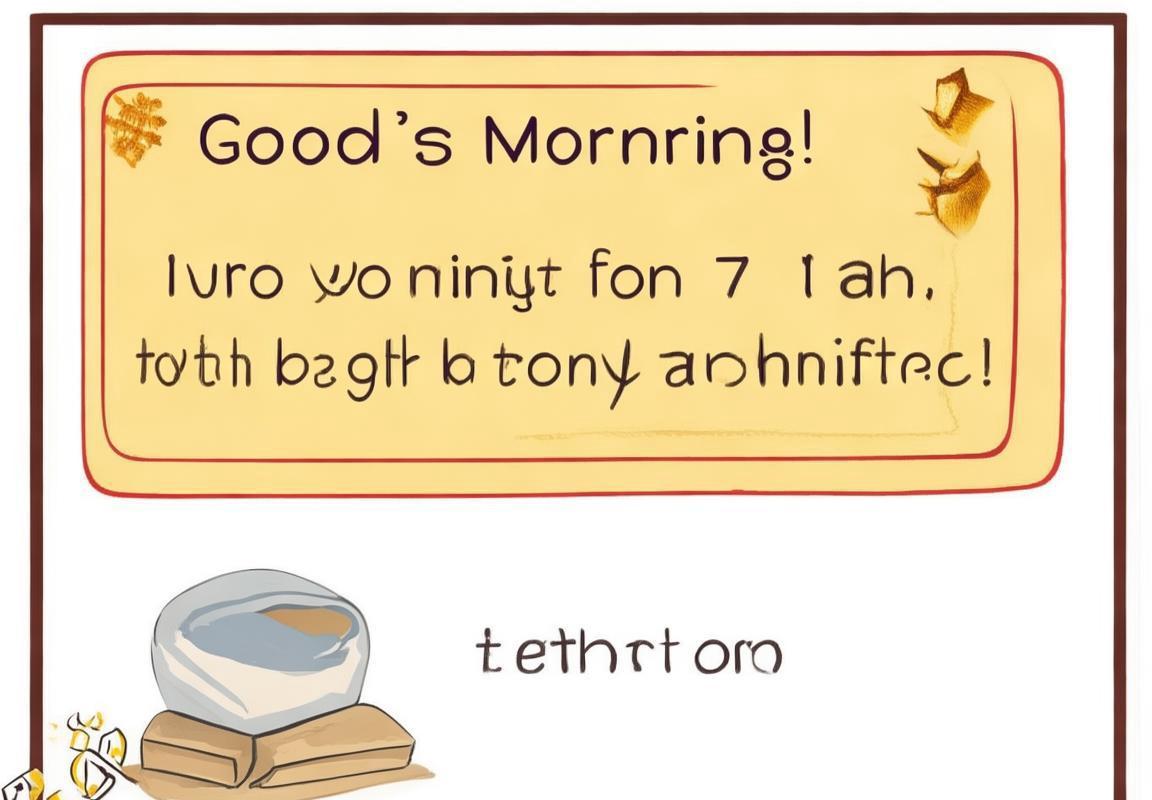
The sea is blue and vast
Con đường dài và rộng mở ra từ bờ biển, nơi đại dương xanh thẳm và mênh mông chào đón tất cả những ai đến thăm. Biển cả như một bức tranh sặc sỡ, nơi những con sóng vỗ vào bờ tạo ra những âm thanh êm dịu. Trời cao trong lành, không có một đám mây nào che bầu trời. Biển lớn như một khúc tràng ca, nơi những con cá bơi lội tự do và những chú chim đại bàng đậu trên các ngọn sóng cao. Những ánh nắng mặt trời chiếu rực rỡ, làm cho mặt nước như một tấm gương phản chiếu cả thế giới xung quanh. Biển không chỉ là một nơi để vui chơi, mà còn là một nhà của biết bao loài động vật biển và những câu chuyện thần thoại.

Danh Sách Từ ẩn
- River
- Sea
- Forest
- Mountain
- Beach
- Lake
- Desert
- Jungle
- Cloud
- Star

Cách Chơi
- Chuẩn Bị:
- Lấy một bộ hình ảnh động vật nước, chẳng hạn như cá, voi biển, và rùa.
- Chuẩn bị một danh sách từ tiếng Anh liên quan đến các loài động vật này.
- Mô Tả Trò Chơi:
- Đặt tất cả các hình ảnh động vật nước trên một bàn hoặc sàn.
- Trẻ em sẽ được yêu cầu đoán từ tiếng Anh liên quan đến mỗi hình ảnh.
- Bước Đầu:
- Chọn một hình ảnh động vật và đặt nó ở trước mặt bạn.
- Hỏi trẻ em: “What animal is this?” (Động vật này là gì?)
- Nếu trẻ em không biết từ tiếng Anh, bạn có thể gợi ý bằng cách nói: “It looks like a fish.” (Nó trông giống như một con cá.)
- Đoán Từ:
- Trẻ em sẽ cố gắng đoán từ tiếng Anh cho hình ảnh đó.
- Nếu trẻ em đoán đúng, bạn có thể khen ngợi và tiếp tục với hình ảnh tiếp theo.
- Nếu trẻ em đoán sai, bạn có thể giúp họ bằng cách gợi ý hoặc đọc từ chính xác ra.
- Hoạt Động Thực Hành:
- Khi trẻ em đoán đúng, bạn có thể yêu cầu họ giải thích từ đó hoặc làm một hoạt động liên quan đến từ đó.
- Ví dụ: Nếu trẻ em đoán “fish” (cá), bạn có thể yêu cầu họ kể một câu chuyện ngắn về một con cá.
- Kết Thúc:
- Sau khi hoàn thành tất cả các hình ảnh, bạn có thể hỏi trẻ em: “What did we learn today?” (Hôm nay chúng ta đã học được điều gì?)
- Trẻ em có thể chia sẻ các từ tiếng Anh mới mà họ đã học và các hoạt động mà họ đã thực hiện.
Lợi Ích:– Giáo Dục: Giúp trẻ em học từ mới và hiểu biết về các loài động vật nước.- Kỹ Năng: Phát triển kỹ năng nghe, nói và tưởng tượng.- Thích Nghi: Cung cấp một cách vui chơi và học tập tích cực thông qua các hình ảnh sinh động.
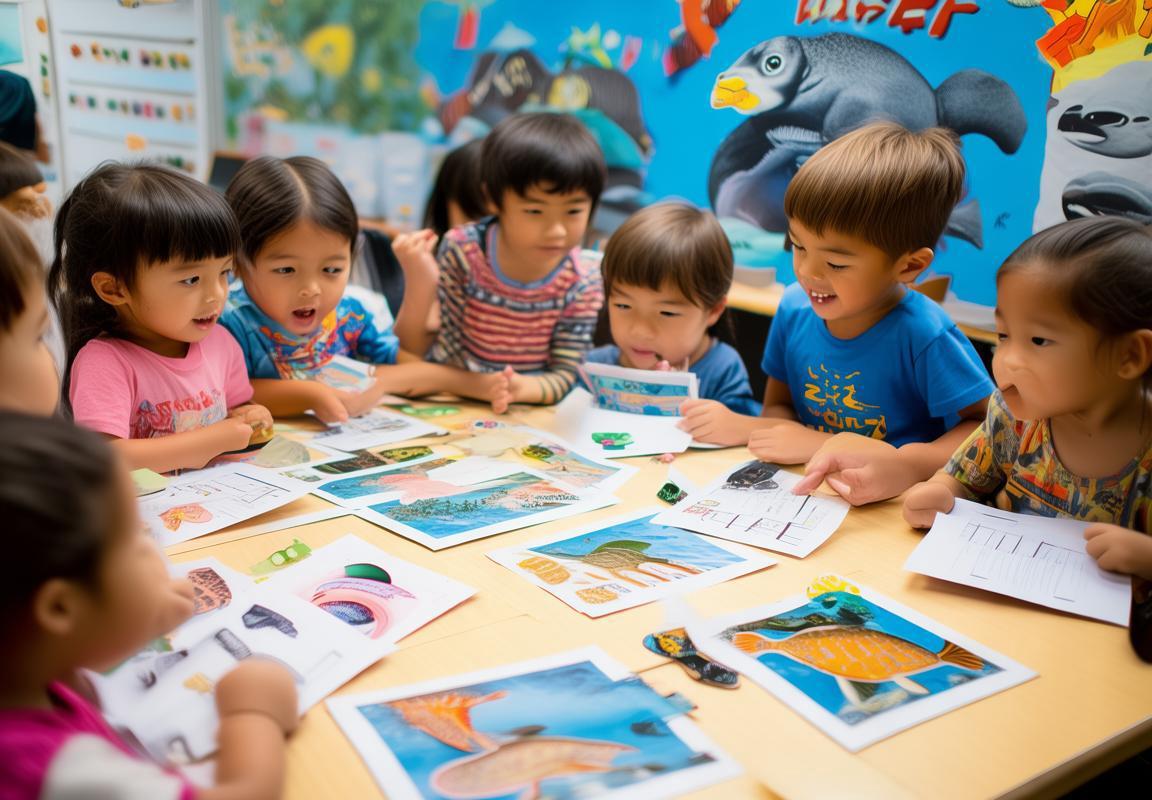
Hoạt Động Thực Hành
Để giúp trẻ em học và nhớ các từ tiếng Anh liên quan đến các bộ phận của cơ thể, có thể thực hiện các hoạt động sau:
- Hoạt Động Vẽ Tranh:
- Trẻ em được yêu cầu vẽ tranh về cơ thể con người, và thêm vào các bộ phận cơ thể như mắt, mũi, miệng, tai, vai, lưng, đùi, gót chân, và tay.
- Sau khi vẽ xong, trẻ em được yêu cầu điểm tên các bộ phận cơ thể bằng tiếng Anh trên tranh của mình.
- Hoạt Động Đoạn Trình Diễn:
- Trẻ em có thể tham gia vào một đoạn trình diễn ngắn, nơi họ diễn tả các hành động liên quan đến các bộ phận cơ thể như “Look at my eyes”, “Smile”, “Nod my head”, “Wave my hand”, “Jump with my legs”, “Touch my nose”.
- Giáo viên hoặc phụ huynh có thể làm mẫu và sau đó trẻ em lặp lại theo.
- Hoạt Động Thực Hành:
- Trẻ em có thể thực hiện các hoạt động thực hành đơn giản như “Point to your nose” hoặc “Touch your ear” để xác nhận họ đã nhớ được các bộ phận cơ thể.
- Giáo viên có thể tạo một trò chơi nhỏ, nơi trẻ em chạy hoặc đi bộ theo các chỉ thị liên quan đến các bộ phận cơ thể như “Run to your feet”, “Jump to your hands”.
- Hoạt Động Thư Viện:
- Trẻ em có thể tham gia vào một buổi thư viện ngắn, nơi họ được đọc các câu chuyện ngắn hoặc sách tranh có chứa hình ảnh và từ tiếng Anh liên quan đến các bộ phận cơ thể.
- Hoạt Động Tạo Dụng Cụ:
- Trẻ em có thể làm các dụng cụ tự làm như “body cards” hoặc “body puzzles”, nơi họ có thể kết hợp các thẻ hoặc mảnh ghép có hình ảnh các bộ phận cơ thể để tạo ra một cơ thể hoàn chỉnh.
Những hoạt động này không chỉ giúp trẻ em học từ mới mà còn thúc đẩy sự sáng tạo và tương tác xã hội.
